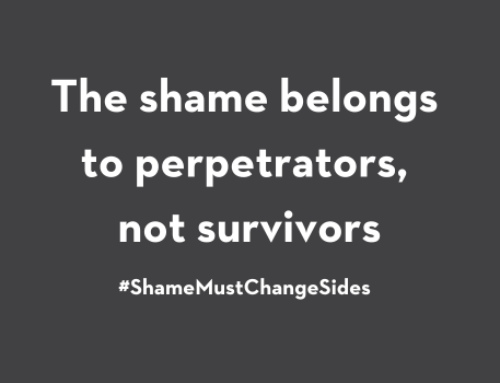Windsor, Nova Scotia, is known as the “birthplace of hockey” and is famous for its giant pumpkins. The population of the town, which is an hour from Halifax, is around 3,700.
When veteran officer Luc Côté got stationed at the Windsor RCMP detachment in April, it was “a bit shocking” to learn his colleagues were working on a sex-trafficking case.
“If you don’t think this is happening in your small town, you’re kidding yourself,” Côté said during a presentation at the Canadian Women’s Foundation’s recent roundtable discussion on sex trafficking in Halifax, NS.
Participants from all over Atlantic Canada
The event drew about 60 stakeholders from every province in Atlantic Canada, including survivors, social service workers, government policy-makers, and law enforcement. It was the second in a series of regional discussions the Foundation is holding as part of its five-year strategy to end sex trafficking.
The Foundation is convening and funding the discussions in an effort to debunk the myths surrounding sexual exploitation, and expose the emerging trends and challenges when it comes to ending this crime. The consultations will ultimately build regional strategies to end trafficking and connect the various parties involved. The Foundation also recently announced it plans to allocate up to $500,000 to anti-trafficking projects over the next five years.
Côté’s presentation at the roundtable underlined the fact that trafficking happens beyond Canada’s big cities. In his work, he’s seen that girls as young as 15 are being trafficked and advertised online. The going rate for their services is about $180/hour. Traffickers, as part of their recruiting strategy, are brazen enough to approach girls hanging out in public places. They may also eventually transport victims from smaller cities into other provinces.
We need to hear survivors’ voices
Though public awareness of the issue is increasing, there are still misconceptions. Melendy, a survivor of sex trafficking who now works with the Coalition Against the Sexual Exploitation of Youth (CASEY) in St. John’s, NFLD, said one of the common myths about sex trafficking is girls and women do it for the money, of their own free will.
By definition, sex trafficking is forced prostitution; girls, women and some men are lured and sexually exploited. The traffickers pocket the money, often using threats, isolation, force or drugs to control their victims.
To fully understand sex trafficking, the voices of survivors must be heard. “Until you actually sit down with someone and hear what they’ve gone through, I don’t know if you can understand it,” Melendy says. Her story is part of a video produced by CASEY to raise awareness about the sexual exploitation of youth. The video is being shown in middle and high schools in Newfoundland and Labrador.
“If we had something like that in Nova Scotia, it would be wonderful,” said Natasha Jamieson, an RCMP officer who has been working on human trafficking for the past three years.
Connecting tools, strategies and people
Jamieson trains front-line officers and workers in Nova Scotia to recognize the signs of sex trafficking and build rapport with survivors. The RCMP recognizes that officers need to build trust in order for victims to come forward. She said there have been seven human trafficking arrests in Nova Scotia since June 2014.
“We have to recognize that we are dealing with victims of a horrendous crime; we need to look at them and treat them as such.”
She also said one of the challenges in the area is the relatively high level of poverty among youth. One in five of Nova Scotia’s children live in poverty, reported the Canadian Centre for Policy Alternatives in 2014. Those vulnerable to poverty may be at higher risk of being trafficked.
Provinces working on policy
While police and service providers work to help individual survivors of sex trafficking, provincial governments in the region are working on developing policy and strategies.
Martine Stewart, with the Women’s Equality Branch of the Government of New Brunswick, presented the work of the New Brunswick Working Group on Human Trafficking. The group aims to raise awareness among service providers and the public, as well as look at best practices when it comes to supporting service providers and helping victims.
Stephanie MacInnis-Langley, Executive Director of the Nova Scotia Status of Women office, led a presentation about the NS Status of Women office’s work on sex trafficking, which includes the establishment of a Child Sexual Exploitation Discussion Table.
The discussion table is looking at how the province can address the issue of sexually exploited youth. The work of the discussion table highlighted the need for a coordinated response, particularly when it comes to helping young people.
Lack of data, evidence
One of the challenges for both service providers and policy makers is the lack of data collection on sex trafficking cases and evidence on strategies that work. The Canadian Women’s Foundation aims to help fill the information gap by funding anti-trafficking programs.
As the grantees move forward with their programs from 2016-2020, their work will help establish informed strategies for prevention and rebuilding lives.
“Being able to fund the programs that are having the most significant impact all across Canada and share that information with the sector is central to our strategy,” says Anuradha Dugal, the Foundation’s Director of Violence Prevention. “We want to fund the programs that help women and girls build the capacity to stop trafficking.”
In the meantime, the Foundation is planning a fall regional roundtable in Manitoba.
“The connections made and information shared at the Halifax roundtable were invaluable,” said Barbara Gosse, the Foundation’s Senior Director of Research, Policy and Innovation. “We need to understand the complexities of this horrific crime, and who better to teach us than survivors and those working to combat this human rights abuse from the front lines. Together we can put an end sex trafficking in Canada.”






